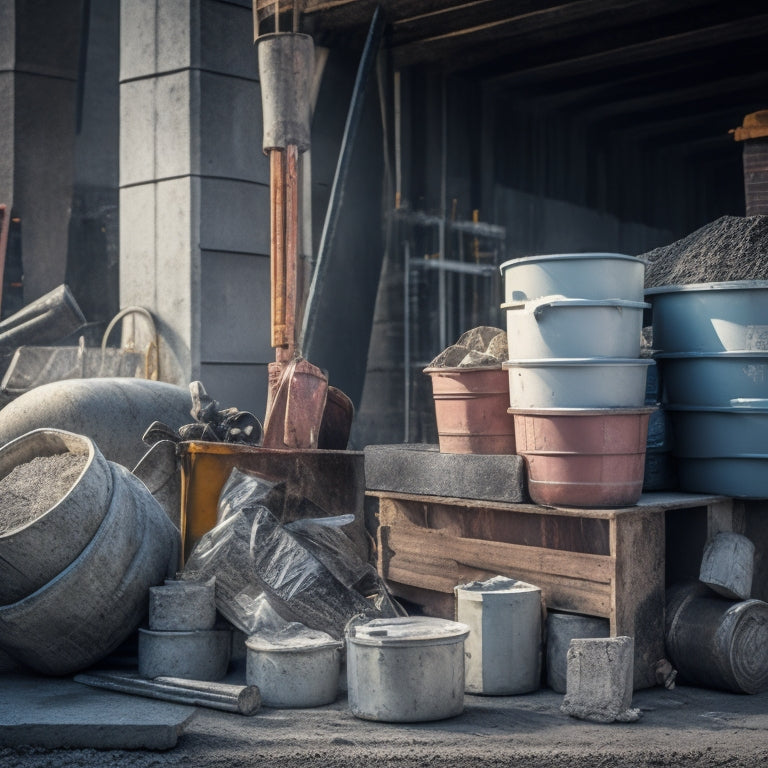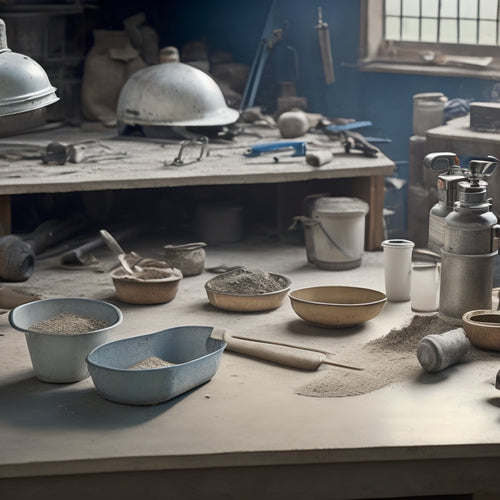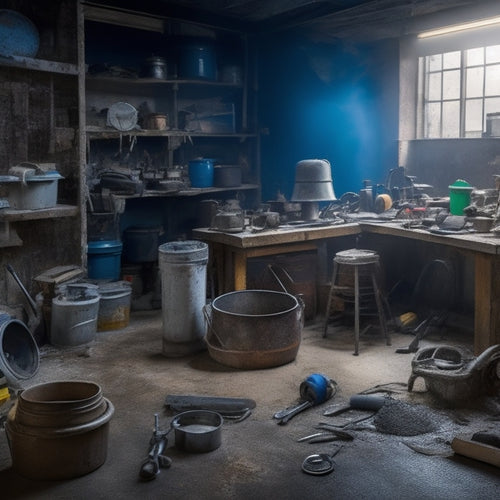
Why Budget for Concrete Construction Tools and Materials
Share
By budgeting for concrete construction tools and materials, you guarantee that your project stays on track, avoiding costly delays and changes that can increase expenses by up to 20%. Accurate estimation of material costs, investing in quality tools, and optimizing labor efficiency can greatly reduce costs. Additionally, budgeting for materials and tools upfront prevents mid-project changes, guarantees compliance with local building codes, and maintains structural integrity. By doing so, you'll avoid costly rework, fines, and potential loss of life. As you move forward with your project, you'll uncover even more ways to optimize your budget and achieve long-term success.
Key Takeaways
• Accurate budgeting for concrete construction tools and materials prevents project delays and cost overruns by ensuring timely material arrival and adequate resources.
• Budgeting for quality tools and materials reduces waste, enhances productivity, and maintains structural integrity, leading to long-term cost savings and durability.
• Efficient labor allocation and reduced labor costs are achieved through streamlined project scheduling, optimized resource allocation, and minimized downtime.
• Thorough project planning and scope management prevent costly mid-project changes, ensuring feasibility and reducing risks of unexpected costs.
• Budgeting for compliance and safety considerations ensures structural integrity, prevents catastrophic failures, and avoids costly rework and fines from non-compliance.
Accurate Estimation of Material Costs
Estimating material costs accurately requires calculating the exact quantity of concrete and other materials needed for the project, taking into account factors like waste, shrinkage, and necessary excess. You don't want to be stuck with a heap of unused materials or, worse, not enough to complete the job.
To avoid these costly mistakes, you'll need to get your cost forecasting game on point. This means considering the specific requirements of your project, including the type and quantity of materials, labor costs, and equipment rentals.
When it comes to material sourcing, you'll want to research suppliers and compare prices to get the best deals. Don't forget to factor in delivery costs and lead times to guarantee your materials arrive on site when you need them.
Quality Tools for Efficient Work
When you're budgeting for concrete construction tools, you'll quickly realize that investing in quality tools is vital for efficient work.
You need durable equipment that can withstand the demands of the job site, precision tooling that guarantees accuracy, and high-quality materials that meet industry standards.
Durable Equipment Matters Most
Investing in high-quality, durable concrete construction tools is essential to ensuring efficient work, as it allows you to complete tasks quickly and effectively, reducing downtime and increasing overall productivity.
You don't want to be stuck with subpar tools that break down on you mid-project, leaving you scrambling to find a replacement.
That's why it's vital to prioritize equipment longevity when making your purchasing decisions. A durable tool may cost more upfront, but it'll save you money in the long run by reducing the need for frequent replacements and repairs.
Precision Tooling Is Key
You can't afford to compromise on precision tooling, as it's what separates mediocre concrete construction from high-quality, precision-driven work that meets exacting specifications and tolerances. With precision tooling, you can guarantee that every pour, every finish, and every detail meets the highest standards. Anything less, and you're risking costly reworks, delays, and a reputation that's anything but solid.
Here's a snapshot of what precision tooling can look like in concrete construction:
| Tool/Technology | Benefit | Impact on Quality |
|---|---|---|
| Precision measurement techniques | Guarantees accuracy down to the mm | Eliminates costly reworks |
| Advanced tooling technologies | Enables complex shapes and designs | Opens new design possibilities |
| High-precision mixers | Consistent batch quality | Uniform strength and finish |
| Laser-guided screeds | Accurate leveling and finishing | Perfectly flat surfaces |
| Automated finishing tools | Reduces manual labor | Faster, more consistent results |
High-Quality Materials Count
Equipped with precision tooling, your concrete construction projects demand high-quality materials that deliver consistent performance, reduce waste, and optimize workflow efficiency. You can't afford to compromise on materials that will ultimately affect the integrity of your structure.
High-quality materials guarantee that your project meets the required standards, and you avoid costly reworks or even worse, safety hazards.
When it comes to material sourcing, it's crucial to compare performance across different suppliers. Don't just focus on the initial cost; consider the long-term benefits. High-quality materials may seem expensive upfront, but they'll save you time, money, and stress in the long run.
A performance comparison will help you identify the best materials for your project, guaranteeing you get the desired results. Remember, cheap materials can lead to costly repairs, reputational damage, and even legal issues.
Reducing Labor Costs and Time
When you're working on a concrete construction project, you know that labor costs can quickly add up and eat into your profits.
To stay on budget, you need to optimize your team's productivity and minimize overtime.
Streamlined Project Scheduling
By implementing a streamlined project scheduling system, concrete construction teams can shave off up to 20% of labor costs and reduce project timelines by as much as 15%. You'll be amazed at how a well-planned schedule can make a significant impact on your bottom line.
With a streamlined system, you can optimize your project timeline by identifying and eliminating bottlenecks, ensuring that each task is completed efficiently and on time.
Effective resource allocation is key to a successful project schedule. By assigning the right resources to the right tasks, you can maximize productivity and minimize downtime. You'll be able to allocate your team's time and energy more effectively, reducing labor costs and ensuring that your project stays on track.
A streamlined project schedule also enables you to identify potential roadblocks and make adjustments before they become major issues. By staying one step ahead, you can avoid costly delays and keep your project moving forward.
With a well-planned schedule, you'll be able to deliver high-quality results on time and within budget – and that's music to any contractor's ears!
Efficient Task Assignment
Optimizing task assignments through a meticulous analysis of your team's skills, strengths, and workload enables you to allocate labor resources more effectively, slashing labor costs and project timelines.
By doing so, you'll avoid assigning tasks that are beyond an individual's capabilities, reducing the likelihood of mistakes and rework. This, in turn, minimizes the need for costly corrections and keeps your project on track.
Effective task delegation also fosters team collaboration, as each member is clear about their responsibilities and how they contribute to the project's overall success.
It's crucial to identify the strengths of each team member and assign tasks that play to those strengths. This not only boosts productivity but also morale, as team members feel more confident and engaged in their work.
By streamlining task assignments, you'll be able to complete projects faster, reduce labor costs, and ultimately, increase profitability.
Minimized Overtime Needs
You can considerably reduce labor costs and project timelines by identifying and addressing inefficiencies that drive overtime needs, allowing you to allocate resources more effectively and maintain a leaner schedule.
By doing so, you'll be able to optimize your labor efficiency and make the most of your team's time. It's all about streamlining processes, eliminating unnecessary tasks, and ensuring that each crew member is working at their highest potential.
When you're not bogged down by inefficiencies, you can focus on the tasks that really matter. This means you'll be able to complete projects faster, reducing the need for overtime and the associated costs.
Overtime reduction isn't just about saving money, though – it's also about reducing burnout and keeping your team happy and motivated. By allocating resources more effectively, you'll be able to maintain a healthy work-life balance for your crew, which means they'll be more productive and engaged on the job.
Avoiding Costly Mid-Project Changes
Concrete construction projects often face the risk of costly mid-project changes, which can be mitigated by carefully planning and specifying tools and equipment requirements upfront. You wouldn't want to be stuck with a project scope that's no longer feasible, would you? By budgeting for the right tools and materials from the get-go, you can avoid those pesky mid-project changes that can blow your budget to smithereens.
Here's a breakdown of how planning ahead can save you from costly changes:
| Change Type | Impact on Budget | Mitigation Strategy |
|---|---|---|
| Scope creep | 10-20% increase | Define project scope clearly, involve stakeholders early |
| Material substitution | 5-10% increase | Specify materials upfront, consider alternatives |
| Equipment rental | 5-10% increase | Plan equipment needs, rent or buy strategically |
| Labor reallocation | 10-20% increase | Identify labor needs, allocate resources efficiently |
| Design revisions | 5-10% increase | Finalize design before construction, involve architects early |
Ensuring Structural Integrity and Safety
During the initial planning stages, it's essential that you factor in the costs of guaranteeing structural integrity and safety. Compromised structures can lead to devastating consequences, including project delays, cost overruns, and even loss of life. You don't want to be that guy who's to explain to the project owner why the building collapsed due to a design flaw or a safety oversight.
To avoid such catastrophes, you'll need to budget for:
-
Experienced engineers and architects: Their expertise in structural design will help you avoid costly mistakes and guarantee that your building can withstand natural disasters and everyday wear and tear.
-
Regular safety inspections: You'll need to hire safety experts to monitor the construction process and identify potential hazards before they cause accidents.
-
Safety training for workers: Your construction team needs to know how to handle heavy machinery, work at heights, and follow safety regulations to prevent accidents and injuries.
Meeting Local Building Code Requirements
In addition to guaranteeing structural integrity and safety, obtaining the necessary permits and approvals requires compliance with local building codes, which can vary greatly from one region to another.
You don't want to get caught off guard by a surprise inspection, only to find out you've missed a vital step in the process. That's why it's important to familiarize yourself with local regulations and perform regular compliance checks throughout the construction process.
Don't assume that what works in one area will work in another - local building codes can be as unique as a snowflake (but less pretty and more bureaucratic). For example, seismic zones have specific requirements for foundation design and reinforcement, while coastal areas have strict guidelines for wind resistance.
By budgeting for the right tools and materials, you can guarantee that your construction project meets the necessary standards and avoids costly rework or fines.
Long-Term Durability and Maintenance
You'll need to factor in the long-term costs of upkeep and repair when selecting tools and materials, as a durable construction is only as strong as its weakest component. It's like the old saying goes: 'you get what you pay for.' Cheap tools and materials might save you some cash upfront, but they'll end up costing you in the long run.
To guarantee your concrete construction stands the test of time, consider the following:
-
Choose materials with sustainability practices in mind: Opt for materials that are eco-friendly, locally sourced, and built to last. This might include recycled aggregate, low-carbon cement, or reusable formwork.
-
Create a maintenance schedule: Regular inspections and maintenance can help extend the life of your construction. Set reminders to check for cracks, clean drains, and perform other essential tasks.
-
Select tools that are built to last: Invest in high-quality tools that can withstand the rigors of repeated use. This might include durable mixing drums, robust tamping tools, or long-lasting finishing equipment.
Frequently Asked Questions
What Is the Ideal Storage Method for Concrete Construction Tools?
When it comes to storing concrete construction tools, you're not just tossing them in a corner and hoping for the best. You're a pro, and pros prioritize tool organization.
You'll want to store your tools in a dry, protected area with minimal exposure to extreme temperatures. Guarantee your storage conditions are clean, dry, and free from moisture to prevent rust and damage.
Label and categorize your tools for easy access, and consider investing in a tool chest or shelving system to keep everything tidy and within reach.
Can I Reuse Concrete Mixing Buckets and Tools?
Oh, you want to reuse those concrete mixing buckets and tools? Go ahead, be a concrete construction cheapskate!
But let's get real, you'll actually be a genius. Reusing those buckets and tools can save you some serious cash.
Think cost savings, baby! The reuse benefits are undeniable - you'll reduce waste, lower your expenses, and still get the job done.
Just make sure you clean them properly to avoid any, ahem, 'concrete' consequences.
How Do I Clean and Maintain Concrete Finishing Tools?
You're wondering how to clean and maintain those concrete finishing tools, huh? Well, let's get down to business!
For tool cleaning, mix baking soda and water to create a paste, then scrub away any dried concrete. Rinse thoroughly and dry with a soft cloth.
For maintenance tips, regularly lubricate moving parts and store tools in a dry place. Don't forget to inspect them regularly for signs of wear – a little TLC goes a long way in extending their lifespan!
Are There Any Eco-Friendly Concrete Construction Materials Available?
You're digging deep for eco-friendly concrete construction materials!
Like a green shoot bursting through the pavement, sustainable options are sprouting up.
You'll find sustainable aggregates, like reclaimed asphalt pavement, and recycled concrete that's been crushed and reused.
These innovative materials reduce waste and the carbon footprint of your project.
Can I Use Local Materials to Reduce Transportation Costs?
You're thinking like a pro! Local sourcing can indeed slash transportation costs.
But, don't sacrifice material quality for the sake of saving a buck. You'll want to guarantee those locally sourced materials meet project specs.
Conduct thorough tests to verify their strength, durability, and performance.
Conclusion
As you finalize your concrete construction project, remember that budgeting for the right tools and materials is essential.
Did you know that according to the National Ready Mixed Concrete Association, the average cost of concrete repair in the US is around $2,500 per incident?
By allocating resources wisely, you can avoid costly mistakes and guarantee a structurally sound, safe, and durable structure that meets local building codes and stands the test of time.
Related Posts
-

What Tools Do You Need for Concrete Success
For concrete success, you'll need a range of essential power tools, including rotary hammers, angle grinders, concret...
-

7 Tools to Fix Damaged Concrete Floors
You're about to tackle that damaged concrete floor, and the right tools are essential for a successful repair. Start ...
-

Ergonomic Concrete Tools for Tight Spaces
When you're tackling concrete work in tight spaces, ergonomic tools are your best bet for comfort and efficiency. The...


